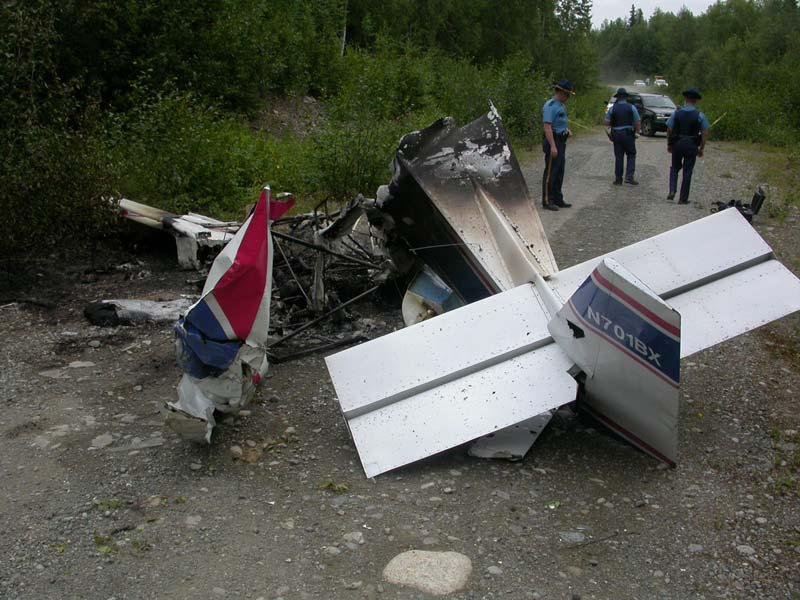
ASN Wikibase Occurrence # 66402
This information is added by users of ASN. Neither ASN nor the Flight Safety Foundation are responsible for the completeness or correctness of this information.
If you feel this information is incomplete or incorrect, you can submit corrected information.
| Date: | Tuesday 14 July 2009 |
| Time: | 09:30 |
| Type: |  Zenair STOL CH 701 A |
| Owner/operator: | Private |
| Registration: | N701BX |
| MSN: | 7-1514 |
| Total airframe hrs: | 529 hours |
| Engine model: | Rotax 912 |
| Fatalities: | Fatalities: 2 / Occupants: 2 |
| Aircraft damage: | Destroyed |
| Category: | Accident |
| Location: | Meadow Lakes, Alaska -
 United States of America United States of America
|
| Phase: | Initial climb |
| Nature: | Private |
| Departure airport: | Wasilla, AK |
| Wasilla, AK | |
| Investigating agency: | NTSB |
| Confidence Rating: |
The commercial pilot and the pilot-rated passenger, a Federal Aviation Administration (FAA) inspector, were on a local flight in the pilot’s float-equipped experimental light sport airplane. The pilot was a light sport designated pilot examiner (DPE) and the purpose of the flight was for the FAA inspector to administer a recurring DPE flight proficiency flight check of the pilot. The airplane departed from a lake near the pilot’s residence and crashed on the lake’s perimeter road. A postcrash fire consumed the majority of the passenger cabin and the inboard portions of each wing. Impact damage was consistent with a near-vertical descent. The composite propeller was burned, however pieces of the propeller had fractured on impact and were found away from the wreckage, indicative of the engine producing power when it crashed. No evidence of any preimpact mechanical anomaly was discovered. A witness living on the lakeshore said the airplane was usually airborne when it passed his house, but on this departure the airplane was still on the water when it passed, and continued out of sight. There was a stand of trees, high brush, and a hill at the departure end of the lake, separating it from the road. There was no evidence that the airplane impacted the trees or the bank. The airplane's weight and balance was calculated using the pilot’s and passenger's weights noted on their FAA medical certificates, 7.5 gallons of fuel predicated on a one-hour flight and 30-minute reserve, and zero baggage weight. The airplane's empty weight, gross weight, and center of gravity (CG) limitations were derived from the accident airplane's maintenance logbooks. The engine’s fuel consumption was estimated from the engine manufacturer's specifications. Baggage weight used was zero, although remnants of fishing gear and other personal items were found in the burnt wreckage, and a survival kit as required by regulation. The airplane's estimated gross weight was 36 lbs over its maximum gross weight, and the center of gravity was near the forward CG limit. Witness statements and evidence suggest that the fire burned intensely for 30-40 minutes. A witness stated that the pilot and passenger were planning to take the airplane fishing after the flight check, which would have required an additional 1.5 hours flight time and additional fuel. It is likely the airplane had more than the minimal 7.5 gallons of fuel onboard used for the weight and balance calculation (it had a 27 gallon capacity), and probably had fishing and survival equipment as well, adding to its already over gross weight. The fact that the airplane took longer to become airborne than usual, and its over gross weight, suggest that the airplane was near the lake’s shoreline and close to rising terrain when it finally became airborne, requiring a steep climb attitude. The lack of evidence of any mechanical problems along with the airplane’s near vertical descent is consistent with a loss of control due to an aerodynamic stall shortly after liftoff.
Probable Cause: The pilot's failure to maintain sufficient airspeed to avoid an aerodynamic stall during takeoff and his decision to fly the airplane over its allowable gross weight. Contributing to the accident was the airplane's excessive gross weight.
Accident investigation:
 |
|
Sources:
NTSB
Location
Images:

Photo: NTSB
Revision history:
| Date/time | Contributor | Updates |
|---|---|---|
| 14-Jul-2009 23:54 | slowkid | Added |
| 15-Jul-2009 07:06 | slowkid | Updated |
| 06-Jun-2010 07:36 | harro | Updated [Source] |
| 21-Dec-2016 19:25 | ASN Update Bot | Updated [Time, Damage, Category, Investigating agency] |
| 02-Dec-2017 15:48 | ASN Update Bot | Updated [Operator, Other fatalities, Departure airport, Destination airport, Source, Narrative] |
Corrections or additions? ... Edit this accident description
The Aviation Safety Network is an exclusive service provided by:


 ©2024 Flight Safety Foundation
©2024 Flight Safety Foundation